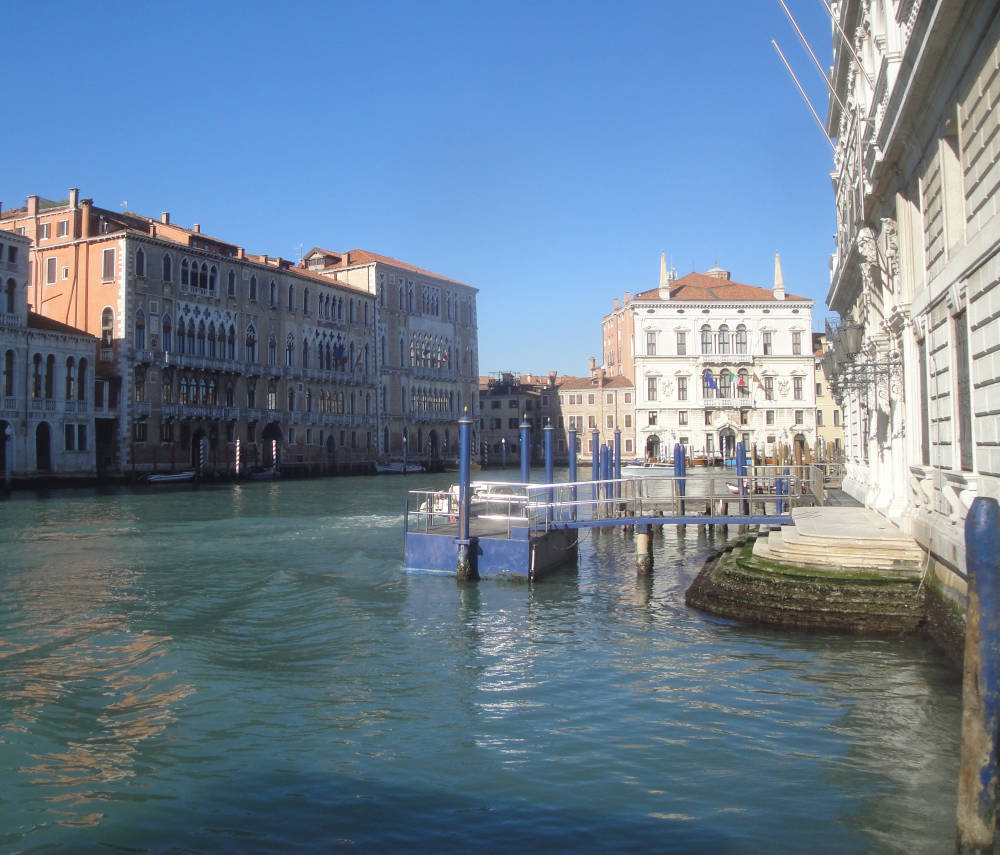Click on images to enlarge them.

For Ruskin the Ca Foscari represented, as he put it in The Stones of Venice, “the noblest example in Venice of the fifteenth century Gothic, founded on the Ducal Palace.” There he added that it is “lately restored and spoiled, all but the stone-work of the main windows. The restoration was necessary, however: for, when I was in Venice in 1845, this palace was a foul ruin; its great hall a mass of mud, used as a back receptacle of a stone-mason’s yard; and its rooms whitewashed, and scribbled over with indecent caricatures. It has since been partially strengthened and put in order; but as the Venetian municipality have now given it to the Austrians to be used as barracks, it will probably soon be reduced to its former condition (11.278).
As the editors of the Library Edition point out, “Ruskin spent much time and labour upon drawing this Palace during his sojourn at Venice with J. D. Harding in 1845” and they quote a letter in which he tells his father, “Harding and I shall do the Foscari pretty well between us. I have got the architecture mouldings, capitals and all. I began it small. Harding said I should frighten the Daguerreotype into fits, and Couttet said: ‘a ne le ressemble pas: c'est la même chose.’ I found it impossible, however, to accomplish it so completely, and am therefore taking large studies of the most interesting part, leaving the rest to sketch in lightly” (8.131n).


While writing The Seven Lamps of Architecture (1848), Ruskin argued that Ca Foscari represented the best of fifteenth-century gothic precisely because it embodied a particular kind of architectural refinement that involved casting off luxuriant decoration for pure form — a kind of architecture, in fact, that seems opposed to the elaborate embellishments called for by the famous chapter “The Nature of Gothic’ in The Stones of Venice. In “The Lamp of Beauty,” for example, he points to one of the window mouldings on the Ca Foscari, which “is, for so simple a group, the grandest in effect I have ever seen” (1.166; see below for Ruskin’s drawing of the window detail)

Window from the Ca' Foscari, Venice. John Ruskin, artist. R. P. Cuff, engraver. 1855. 7 x 4 5/32 inches (Plate VIII, The Seven Lamps of Architecture 8.132). Note: Since the circular detail at the top center of the plate doesn't seem to exist in the building as it appears today, one has to assume that it was one of the losses that Ruskin mentions.
In making this point in “The Lamp of Power” he pointed out that Gothic architecture in Venice differed from that in other parts of Italy by its relative restraint. Elsewhere in Italy, architects continually refined their ornament, and “that refinement of ornament was their weak point however, and opened the way for the renaissance attack. They fell, like the old Romans, by their luxury, except in the separate instance of the magnificent school of Venice” (8.130). The Venetians, Ruskin claimed, gradually simplified their ornamentation, striving to emphasize pure forms. Venetian “architecture began with the luxuriance in which all others expired: it founded itself on the Byzantine mosaic and fretwork; and laying aside its ornaments, one by one, while it fixed its forms by laws more and more severe, stood forth, at last, a model of domestic Gothic, so grand, so complete, so nobly systematised, that, to my mind, there never existed an architecture with so stern a claim to our reverence” (8.130).
Anticipating that readers with a knowledge of architectural history will argue that the ancient Greeks did the same thing, he informs the reader, “I do not except even the Greek Doric: the Doric had cast nothing away; the fourteenth century Venetian had cast away, one by one, for a succession of centuries, every splendour that art and wealth could give it. It had laid down its crown and its jewels, its gold and its colour, like a king disrobing: it had resigned its exertion, like an athlete reposing; once capricious and fantastic, it had bound itself by laws inviolable and serene as those of Nature herself. It retained nothing but its beauty and its power; both the highest, but both restrained. The Doric flutings were of irregular number the Venetian mouldings were unchangeable” (8.130-31). Providing an example from the Ca Foscari. Ruskin concludes, “I do not know so magnificent a marking of human authority as the iron grasp of the Venetian over his own exuberance of imagination; the calm and solemn restraint with which, his mind filled with thoughts of flowing leafage and fiery life, he gives those thoughts expression for an instant, and then withdraws within those massy bars and levelled cusps of stone” (8.131).

Ca Foscari with the Palazzo Giustiani at the left.


Left: Looking past the Palazzo Giustiani, which is closest to the viewer, to Ca Foscari and the bend in the Grand Canal. Right: A Closer view of Palazzo Giustiani and Ca Foscari from across the canal.
More of Ruskin's Venice
- St. Mark’s
- The Palazzo Ducale, Venice
- The Scuola de San Rocco
- On the Grand Canal
- Leaving the Grand Canal
- On the way to Venice from the mainland
- Venice: Details and Corners
Photographs 2020. [You may use these images without prior permission for any scholarly or educational purpose as long as you (1) credit the photographer and (2) link your document to this URL in a web document or cite the Victorian Web in a print one.]
Bibliography
Ruskin, John. The Works. Ed. E. T. Cook and Alexander Wedderburn. “The Library Edition.” 39 vols. London: George Allen, 1903-1912.
� �
Last Modified 19 March 2020